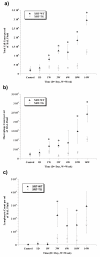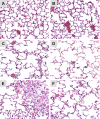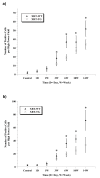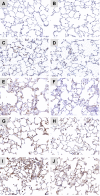Overexpression of extracellular superoxide dismutase reduces acute radiation induced lung toxicity
- PMID: 15949035
- PMCID: PMC1177930
- DOI: 10.1186/1471-2407-5-59
Overexpression of extracellular superoxide dismutase reduces acute radiation induced lung toxicity
Abstract
Background: Acute RT-induced damage to the lung is characterized by inflammatory changes, which proceed to the development of fibrotic lesions in the late phase of injury. Ultimately, complete structural ablation will ensue, if the source of inflammatory/fibrogenic mediators and oxidative stress is not removed or attenuated. Therefore, the purpose of this study is to determine whether overexpression of extracellular superoxide dismutase (EC-SOD) in mice ameliorates acute radiation induced injury by inhibiting activation of TGFbeta1 and downregulating the Smad 3 arm of its signal transduction pathway.
Methods: Whole thorax radiation (single dose, 15 Gy) was delivered to EC-SOD overexpressing transgenic (XRT-TG) and wild-type (XRT-WT) animals. Mice were sacrificed at 1 day, 1 week, 3, 6, 10 and 14 weeks. Breathing rates, right lung weights, total/differential leukocyte count, activated TGFbeta1 and components of its signal transduction pathway (Smad 3 and p-Smad 2/3) were assessed to determine lung injury.
Results: Irradiated wild-type (XRT-WT) animals exhibited time dependent increase in breathing rates and right lung weights, whereas these parameters were significantly less increased (p < 0.05) at 3, 6, 10 and 14 weeks in irradiated transgenic (XRT-TG) mice. An inflammatory response characterized predominantly by macrophage infiltration was pronounced in XRT-WT mice. This acute inflammation was significantly attenuated (p < 0.05) in XRT-TG animals at 1, 3, 6 and 14 weeks. Expression of activated TGFbeta1 and components of its signal transduction pathway were significantly reduced (p < 0.05) at later time-points in XRT-TG vs. XRT-WT.
Conclusion: This study shows that overexpression of EC-SOD confers protection against RT-induced acute lung injury. EC-SOD appears to work, in part, via an attenuation of the macrophage response and also decreases TGFbeta1 activation with a subsequent downregulation of the profibrotic TGFbeta pathway.
Figures







Similar articles
-
Overexpression of extracellular superoxide dismutase protects mice from radiation-induced lung injury.Int J Radiat Oncol Biol Phys. 2003 Nov 15;57(4):1056-66. doi: 10.1016/s0360-3016(03)01369-5. Int J Radiat Oncol Biol Phys. 2003. PMID: 14575837
-
Extracellular superoxide dismutase in the airways of transgenic mice reduces inflammation and attenuates lung toxicity following hyperoxia.J Clin Invest. 1999 Apr;103(7):1055-66. doi: 10.1172/JCI3816. J Clin Invest. 1999. PMID: 10194479 Free PMC article.
-
Chinese medicine Angelica sinensis suppresses radiation-induced expression of TNF-alpha and TGF-beta1 in mice.Oncol Rep. 2006 Jun;15(6):1429-36. Oncol Rep. 2006. PMID: 16685376
-
Current view of the role of transforming growth factor beta 1 in skin carcinogenesis.J Investig Dermatol Symp Proc. 2005 Nov;10(2):110-7. doi: 10.1111/j.1087-0024.2005.200403.x. J Investig Dermatol Symp Proc. 2005. PMID: 16363062 Review.
-
A role for TGFbeta signaling in the pathogenesis of psoriasis.J Invest Dermatol. 2010 Feb;130(2):371-7. doi: 10.1038/jid.2009.252. Epub 2009 Aug 27. J Invest Dermatol. 2010. PMID: 19710682 Free PMC article. Review.
Cited by
-
Leukocyte-derived extracellular superoxide dismutase does not contribute to airspace EC-SOD after interstitial pulmonary injury.Am J Physiol Lung Cell Mol Physiol. 2012 Jan 1;302(1):L160-6. doi: 10.1152/ajplung.00360.2010. Epub 2011 Oct 14. Am J Physiol Lung Cell Mol Physiol. 2012. PMID: 22003088 Free PMC article.
-
Paradoxical Roles of Antioxidant Enzymes: Basic Mechanisms and Health Implications.Physiol Rev. 2016 Jan;96(1):307-64. doi: 10.1152/physrev.00010.2014. Physiol Rev. 2016. PMID: 26681794 Free PMC article. Review.
-
Use of Electron Paramagnetic Resonance (EPR) to Evaluate Redox Status in a Preclinical Model of Acute Lung Injury.Mol Imaging Biol. 2024 Jun;26(3):495-502. doi: 10.1007/s11307-023-01826-5. Epub 2023 May 16. Mol Imaging Biol. 2024. PMID: 37193807 Free PMC article.
-
Effect of 3,3'-Diindolylmethane on Pulmonary Injury Following Thoracic Irradiation in CBA Mice.Health Phys. 2020 Dec;119(6):746-757. doi: 10.1097/HP.0000000000001257. Health Phys. 2020. PMID: 32384373 Free PMC article.
-
The role of oxidative stress-related genes in idiopathic pulmonary fibrosis.Sci Rep. 2025 Feb 18;15(1):5954. doi: 10.1038/s41598-025-89770-y. Sci Rep. 2025. PMID: 39966531 Free PMC article.
References
-
- Vujaskovic Z, Marks LB, Anscher MS. The physical parameters and molecular events associated with radiation-induced lung toxicity. Semin Radiat Oncol. 2000;10:296–307. - PubMed
-
- Rubin P, Finkelstein J, Shapiro D. Molecular biology mechanisms in the radiation induction of pulmonary injury syndromes: interrelationship between the alveolar macrophage and the septal fibroblast. Int J Radiat Oncol Biol Phys. 1992;24:93–101. - PubMed
Publication types
MeSH terms
Substances
Grants and funding
LinkOut - more resources
Full Text Sources
Other Literature Sources
Molecular Biology Databases
Miscellaneous

